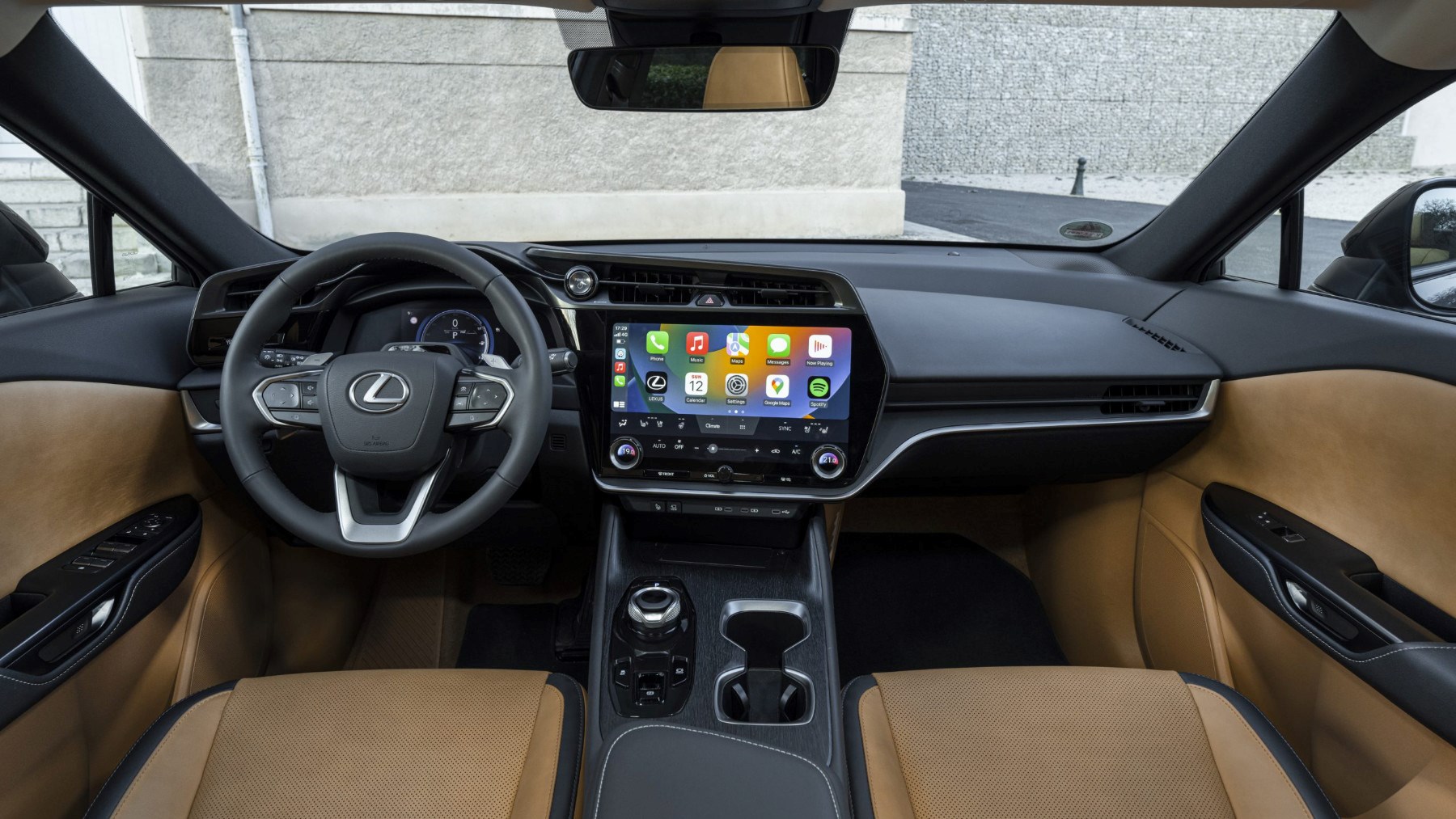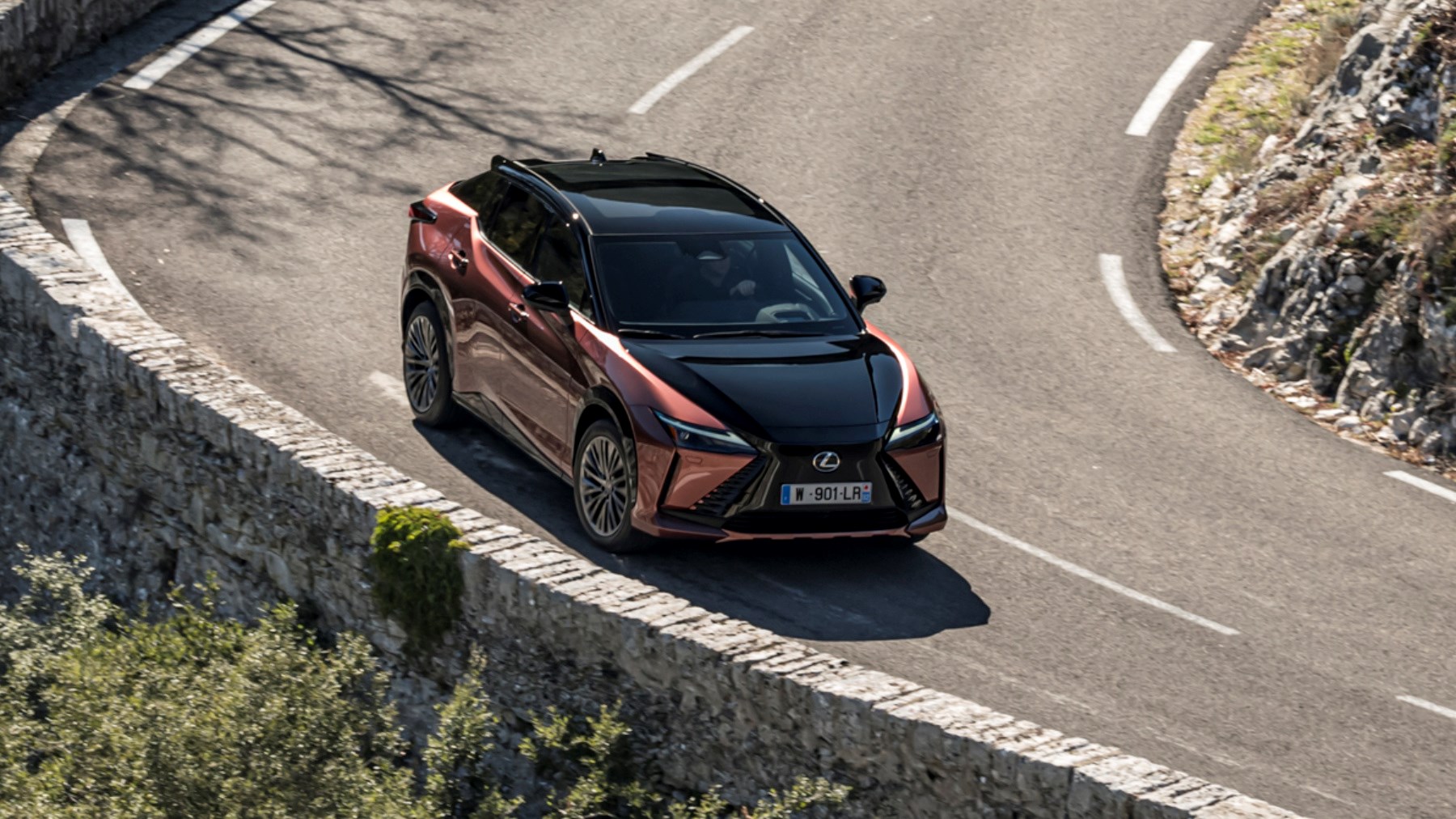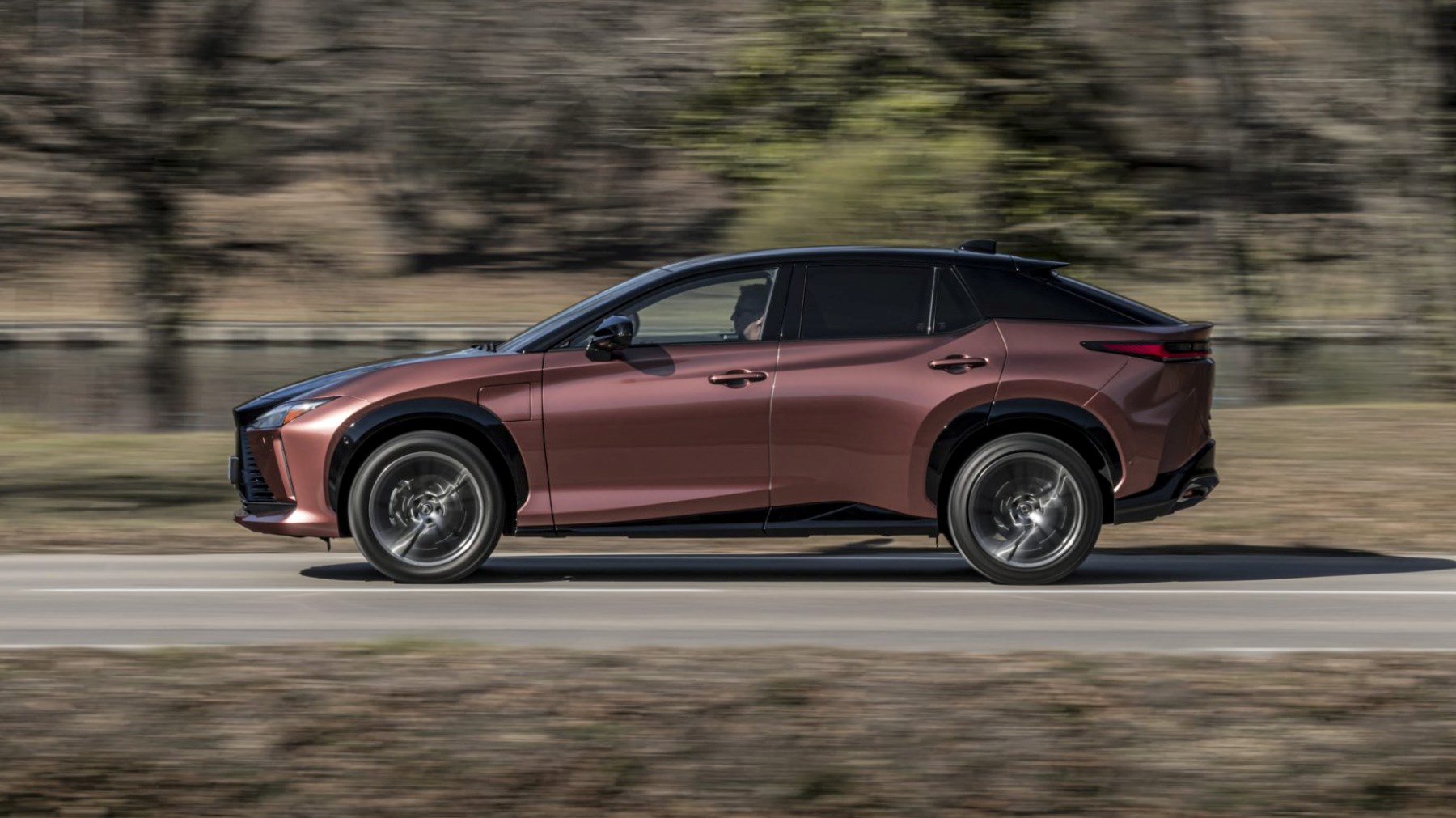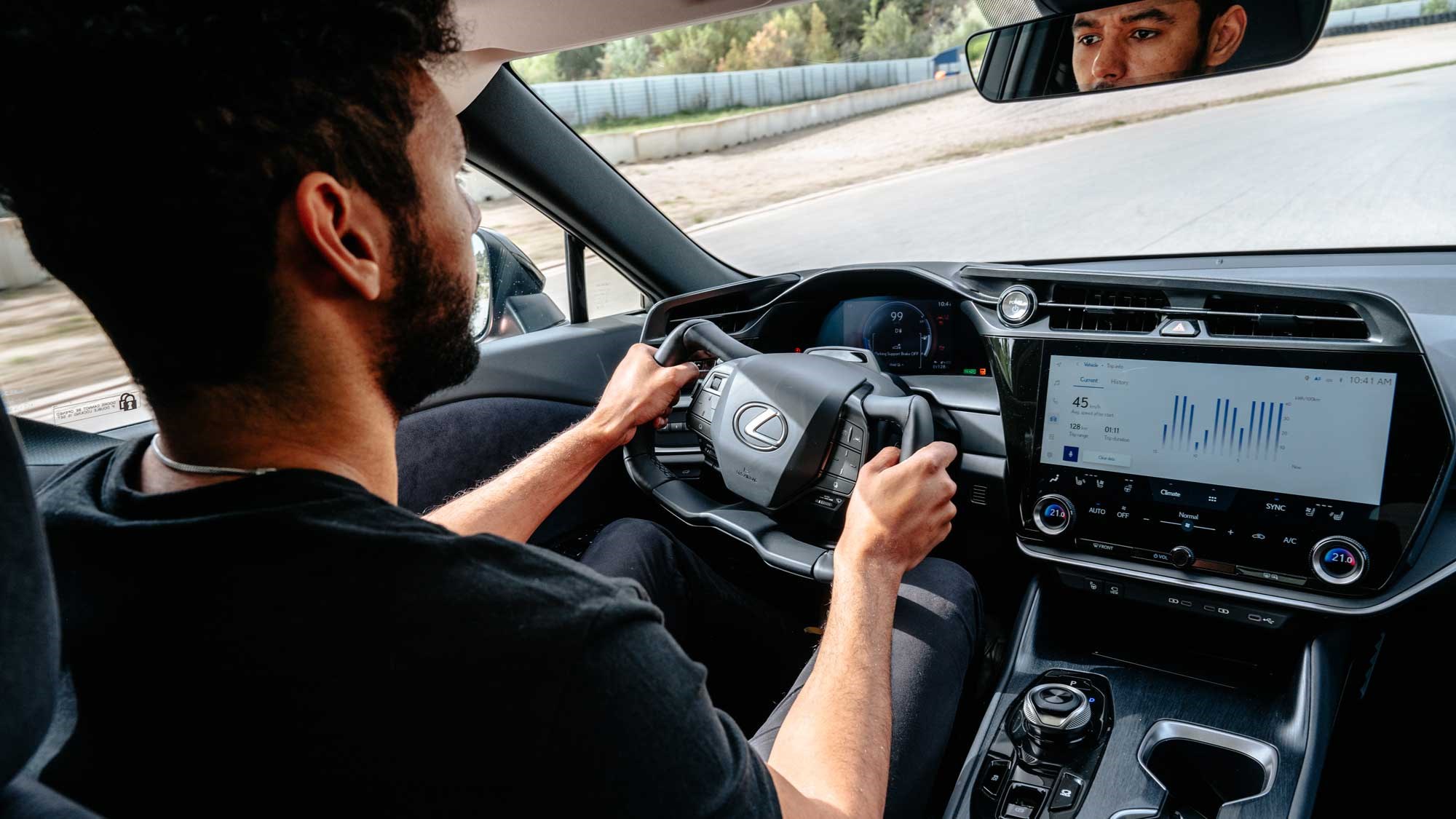► First bespoke Lexus EV driven
► Showstopping interior
► Not so great electric range
Musk’s Minions are gonna have a field day with the new Lexus RZ. We reckon the range of Lexus’ first ever bespoke EV, starting at nearly £63,000, is just over 200 miles.
You see, earlier this year Toyota had to make some changes to the bZ4X following criticisms of its real-world range differing hugely from its WLTP projection.
Lexus, acutely aware of this, has made a fair few alts to the RZ in order to rectify some of the range in advance of customer launch. Interestingly, one of those changes is simply training sales staff to be more up front with customers about how far the car will actually go between charges.
Range, of course, is merely one yardstick from which to measure an electric car. But it’s the most important and the easiest for regular car buyers to understand.
Shall we talk about the car?
The Lexus RZ450e uses the same e-TNGA platform as the Toyota bZ4X. But where the Toyota aims to conquer steep hills and off-road conditions, the Lexus takes a more premium spin and keeps a more road-centric focus.
Like the bz4X, the Lexus uses a 71.4kWh battery to power two motors (201bhp on the front axle and 107bhp on the rear) but now for a combined output of 309bhp – good enough for a brisk 0-62mph time of just 5.6 seconds.
The Lexus also benefits from a Range Mode (no air-con, limited max speed) which should quell some of that range anxiety…
Interior
A premium EV wouldn’t be complete without a showstopping infotainment set-up. It’s an imposing 14.0-inch screen, with Android Auto/Apple CarPlay, a fast response time and an app filled with the usual creature comforts.

Truth be told, it can be a bit fiddly to operate. The climate controls are on neat configurable dials, like on a Land Rover, but the driving modes are on the screen, buried deep within a sub-menu. If you spend too long scrolling looking for features, the car’s facial monitoring cameras will then pick up on it and drive you nuts with some bongs.
Radiant heaters, which act a bit like a blanket by blowing warm air around your knees, work in conjunction with the heated seats. They speed up the warm-up process for occupants in winter and Lexus reckons it’s worth around eight miles of range. It works really nicely, and is a clever bit of tech, much like the dimmable panoramic roof that can switch from transparent to opaque at the touch of a button.
Lexus RZ review: what’s it like to drive?
Although it’s based on the same platform as the bz4X, and also uses the same Subaru developed four-wheel-drive system (called Direct4 here) as the Toyota, the Lexus is nicely stable at higher speeds, and feels more composed in faster driving.
The all-wheel drive system uses ‘predictive factors’ to improve the driving experience, says Lexus. For instance, it can sense lateral g, wheel angle and throttle, throwing it all together for maximum traction. It’s probably most usefully felt in the different driving modes. In Sport, it’ll heighten torque depending on a few variations and shuffle the power around the axles. It works. It certainly slings out of a tight bend and you can feel all four wheels getting in on the mix.

Combine that with smooth electric power delivery and you’ve got a well-mannered crossover that feels every bit a Lexus.
It may lack the snap acceleration of a Tesla, but on the smaller 18-inch wheels the ride is much, much better than anything the Texan outfit can offer. It really soaks up potholes with minimal fuss. Very little road and tyre noise enters the cabin, and the driver assist systems are remarkably chilled.
Range
Ah yes, the all-important question of EV range in our Lexus RZ review. The WLTP maximum range is claimed at 270 miles, with most RZ variants running 20-inch wheels scoring more like 245 miles.
Theoretically, consumption is rated between 3.3 and 3.7 miles per kWh, which is better than the BMW iX3, Mercedes EQC and Audi e-Tron.
However, on our testing of mixed route driving roads at around 7deg C, we saw more like 2.8 miles per kWh, and on stretches, even less. At one point the range predictor indicated a mere 150 miles on a nearly full battery.

Conservatively, we reckon a 210-mile range is probably about right for the Lexus RZ. We’ll update this review once we’ve done some more thorough testing, but this is poor. A Tesla Model Y will easily do 300 miles between charges.
On the flip slide, Lexus does seem confident about the longevity of its battery. The batteries are expected to retain around 90% capacity even after 10 years, the company claims.
Lexus OneMotion: the yoke for a steering wheel
Slated for a 2025 on-sale date, the OneMotion Grip is Toyota and Lexus’s spin on steer-by-wire. It can be divided into two parts – the yoke you use to steer, and the technology between it and the wheels. Both cars can be fitted with conventional steering or with the new steer-by-wire system which we’ve tested in prototype form.
Designed as a butterfly-shaped control the yoke offers 150 degrees of movement lock-to-lock, with everything on the wheel – including the indicators – moving with your hands. This is the key difference compared to Tesla’s system; although the Tesla wheel is a yoke, everything between it and the wheels remains conventional, so it requires lots of turning. Lastly, the space-saving above and below the drivers’ hands means the cockpit dials are higher, easier to see and not interrupted by the rest of the wheel.
After a turning input is made, data is sent to the steering control actuator where it’s then decoded into steering movement. Road surface information is collected by the steering control actuator and represented through the yoke using a steering torque actuator. In effect, this is where the road feel gets added so the driver knows what’s going on at the front axle.

Steering this way has two benefits: firstly, it prevents unwanted vibrations and information from the road surface coming through the wheel and unsettling the driver. Lexus engineers have tuned how much feedback they think is appropriate for an SUV. Later, we’re told that the same system could transmit far more information and torque if it was used in a supercar, for example.
In contrast, off-road driving would require far less information to be transmitted both to and from the wheels, giving a more relaxed driving experience, so the wheel isn’t writhing in your hand as you cross a bumpy gymkhana field.
Other benefits of a yoke? Steer-by-wire means engineers can tune the steering response depending on your speed: higher speeds dull response, while lower speeds give you more control. Thanks to this torque motor and extra redundancy systems, the steer-by-wire system is actually heavier than the conventional one.
More on steer-by-wire tech
Verdcit
The Lexus RZ450e feels like a more premium version of the Toyota bz4X, for better or worse. It drives nicely, features a clean interior and also has more upmarket styling compared to its e-TNGA sibling. But like the Toyota, the Lexus suffers from a conservative spec sheet – and that could prove an issue in the constantly changing landscape of modern EVs.
What isn’t conservative is the yoke system, which really does feel like the perfect match to an EV powertrain. Easier and more economical, it feels like a true counterpart to the Lexus’s linear power delivery. At times it felt a little less connected than we’d like, though it’s possible that’s more down to the fact it’s been tuned for an electric crossover, rather than an all-out sports car.
Lexus and Toyota’s main issue won’t be the technology itself, but how to convince customers it’s best for them in a test-drive environment.
More Lexus reviews